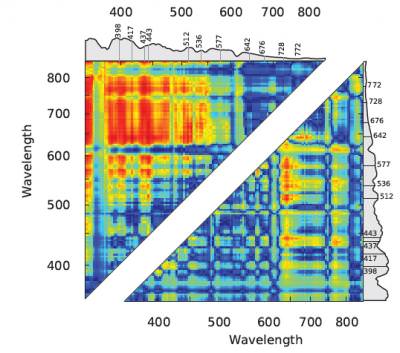[/caption]
Cosmologists have found a new and quicker technique that establishes the intrinsic brightness of Type Ia supernovae more accurately than ever before. These exploding stars are the best standard candles for measuring cosmic distances and are the tools that made the discovery of dark energy possible. An international team has found a way to do the job of measuring stellar distances in just a single night as opposed to months of observations by simply measuring the ratio of the flux (visible power, or brightness) between two specific regions in the spectrum of a Type Ia supernova. With this new method, a supernova’s distance can be determined to better than 6 percent uncertainty.
Using classic methods, which are based on a supernova’s color and the shape of its light curve – the time it takes to reach maximum brightness and then fade away – the distance to Type Ia supernovae can be measured with a typical uncertainty of 8 to 10 percent. But obtaining a light curve takes up to two months of high-precision observations. The new method provides better correction with a single night’s full spectrum, which can be scheduled based on a much less precise light curve.
Members of the international Nearby Supernova Factory (SNfactory), a collaboration among the U.S. Department of Energy’s Lawrence Berkeley National Laboratory, a consortium of French laboratories, and Yale University, searched the spectra of 58 Type Ia supernovae in the SNfactory’s dataset and found the key spectroscopic ratio.
The new brightness-ratio correction appears to hold no matter what the supernova’s age or metallicity (mix of elements), its type of host galaxy, or how much it has been dimmed by intervening dust.
Team member Stephen Bailey from the Laboratory of Nuclear and High-Energy Physics (LPNHE) in Paris, France, says that the SNfactory’s library of high-quality spectra is what made his successful results possible. “Every supernova image the SNfactory takes is a full spectrum,” he says. “Our dataset is by far the world’s largest collection of excellent Type Ia time series, totaling some 2,500 spectra.”
The most accurate standardization factor Bailey found was the ratio between the 642-nanometer wavelength, in the red-orange part of the spectrum, and the 443-nanometer wavelength, in the blue-purple part of the spectrum. In his analysis he made no assumptions about the possible physical significance of the spectral features. Nevertheless he turned up multiple brightness ratios that were able to improve standardization over current methods applied to the same supernovae.
SNfactory member Rollin Thomas of Berkeley Lab’s Computational Research Division, who analyzes the physics of supernovae, says, “While the luminosity of a Type Ia supernova indeed depends on its physical features, it also depends on intervening dust. The 642/443 ratio somehow aligns those two factors, and it’s not the only ratio that does. It’s as if the supernova were telling us how to measure it.”
The Nearby Supernova Factory describes the discovery of the new standardization technique in an article in the forthcoming issue of the journal Astronomy & Astrophysics, and the abstract is available online.
Source: Berkeley


Very cool. Sounds like we will gain an order of magnitude better data from this new process of measuring the spectra. Just shows how valuable the existing data sets can be, even as we focus much of the research time and money collecting new data.
This spectrophotometric method seems to have several advantages over the traditional photometric method of measuring and comparing the lightcurve of the SN to templates. Dust invariance also seems to be another advantage of this technique, along with improved accuracy, of course. ( You might want to check your link to the paper, Nancy, as it’s slightly amiss ). Overall, an interersting paper on a very hot topic in astronomy today. Thanks for the heads up, Nancy 🙂
This is similar in its logic to Levitt’s discovery of luminosity-periodicity relationship is Cephied variables. Deja vu all over again.
Thanks Jon — the link has been fixed!